Anomalocaris
https://reasonandscience.catsboard.com/t2613-anomalocaris-another-science-fiction-like-creature
Stephen Meyer, Darwin's doubt, page 54:
There are many types of arthropods that arise suddenly in the Cambrian—trilobites, Marrella, Fuxianhuia protensa, Waptia, Anomalocaris —and all of these animals had hard exoskeletons or body parts. Moreover, the only known extant group of arthropods without a hard exoskeleton (the pentastomids) have a parasitic relationship with arthropods that do. Thus, surely, it seems likely that some of the near ancestors of the many arthropod animals that arose in the Cambrian would have left at least some rudimentary remains of exoskeletons in the Precambrian fossil record—if, in fact, such ancestral arthropods existed in the Precambrian and if arthropods arose in a gradual Darwinian way. Moreover, the arthropod exoskeleton is part of a tightly integrated anatomical system. Specific muscles, tissues, tendons, sensory organs—and a special mediating structure between the soft tissue of the animal and the exoskeleton called the endophragmal system—are all integrated to support the process of molting and exoskeletal growth and maintenance that is integral to the arthropod mode of existence.
A best-case Darwinian scenario for the origin of such a system would, therefore, envision the “co-evolution” of these separate anatomical subsystems in a coordinated fashion, since some of these anatomical subsystems confer a functional advantage to the animal largely by supporting, and promoting, the growth and maintenance of the exoskeleton (and vice versa). Others would be vulnerable to damage without it. Thus, it seems unlikely that these interdependent subsystems would evolve independently first without an exoskeleton, only to have the exoskeleton arise suddenly as a kind of accretion atop an already integrated system of soft parts at the end of a long evolutionary process.
This, again, makes it reasonable to expect that at least some rudimentary arthropod hard parts would have been preserved in the Precambrian if arthropods were present then. That such parts are unknown for all Cambrian arthropods (and brachiopods) in a fossil record that presumably favors hard-part preservation, seems at least curious. And it appears, on its face, to support the assertions of those Cambrian paleontologists such as Chen and Zhou who take the absence of any hard parts in the Precambrian record as evidence of the absence of those groups that typically depend on hard parts for their existence.
https://www.youtube.com/watch?v=ice47loNmsc
The Anomalocarid Bauplan 2
The studies of the mid to late 1990s have presented us with intriguing revelations, and the most complete fossils of anomalocaridids. The level of current research and discovery is at its most promising since Whittington and Briggs (1982, 1985) pieced together the first reasonable reconstruction of Anomalocaris.
The anomalocaridid bauplan (body plan)
All anomalocaridids are bilaterally symmetrical, bear a pair of anterior segmented appendages, these often sclerotized and armed with spines, a ventral anterior mouth is comprised of tooth-bearing sclerotized wedge-shaped segments arranged in a ring around a central aperture. Jaws, jaw segments, and anterior claws are more often preserved than the rest of the animal, suggesting that these parts are the most robust. Dorsolateral prominent eyes, most often a single pair placed to either side of the mouth, but sometimes either anterior or posterior of the mouth, are typically set on flexible stalks of various length. An elongate, metameric body bears numerous (typically 10+) pairs of lateral imbricating lobes, probably of natatorial function, sometimes accompanied by repeating sets of horizontal support rods. In the majority of species for which complete specimens are known, there are (typically three) pairs of prominent dorsolateral fins immediately posterior to the lateral lobes. 2

1

An Eye-Opening Discovery: The Remarkable Vision of Anomalocaris 3
December 8, 2011
The creature is in the news today thanks to new revelations about its fantastic vision. Sadly, it’s proven to be another tough day to be a Darwinian.
Like something out of science fiction, Anomalocaris (whose name means “strange shrimp”), with lengths ranging up to two meters, propelled itself with ease through the Cambrian waters by moving the lobes on the side of its body in a smooth, wavelike motion.
Bizarrely, the eyes of Anomalocaris were positioned on stalks on the side of the animal’s head. The popular science media are abuzz about a recent discovery — published in Nature and based on fossils found on Kangaroo Island, South Australia — that Anomalocaris possessed compound eyes similar to those that modern insects and arthropods have today. The only difference is that Anomalocaris had even more lenses per eye (according to the Paterson et al. Nature article, as many as 16,000 hexagonal lenses per eye) than most of those modern groups do. These remarkable eyes (which presumably would have required a reasonably advanced brain) would have afforded the creature very sharp vision. In fact, according to the Nature News report,
It is possible that the eyes of Anomalocaris had even more than 16,000 lenses — the fossils are detailed, but they are not perfect. In fossil form, the stalked eyes are flattened, like pancakes. But Paterson speculates that the eyes of a living anomalocaridid would have been bulbous, and that if non-flattened eyes were to be found, many more lenses would be discovered on the other side.
4
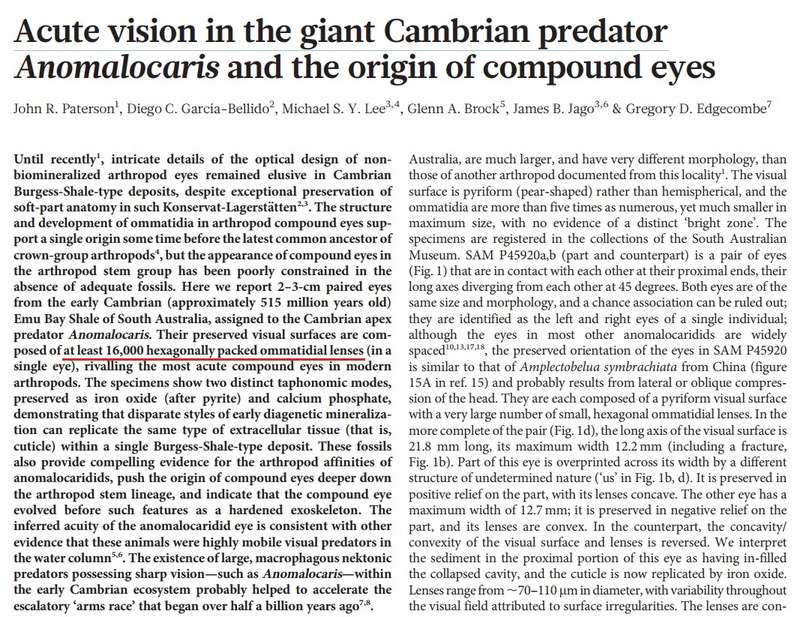
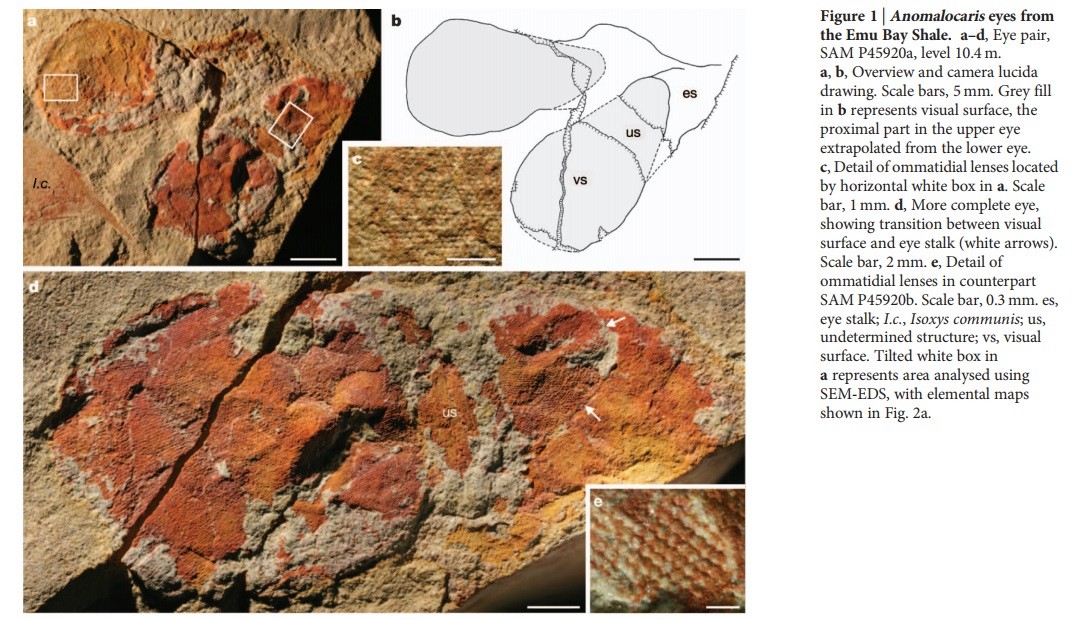
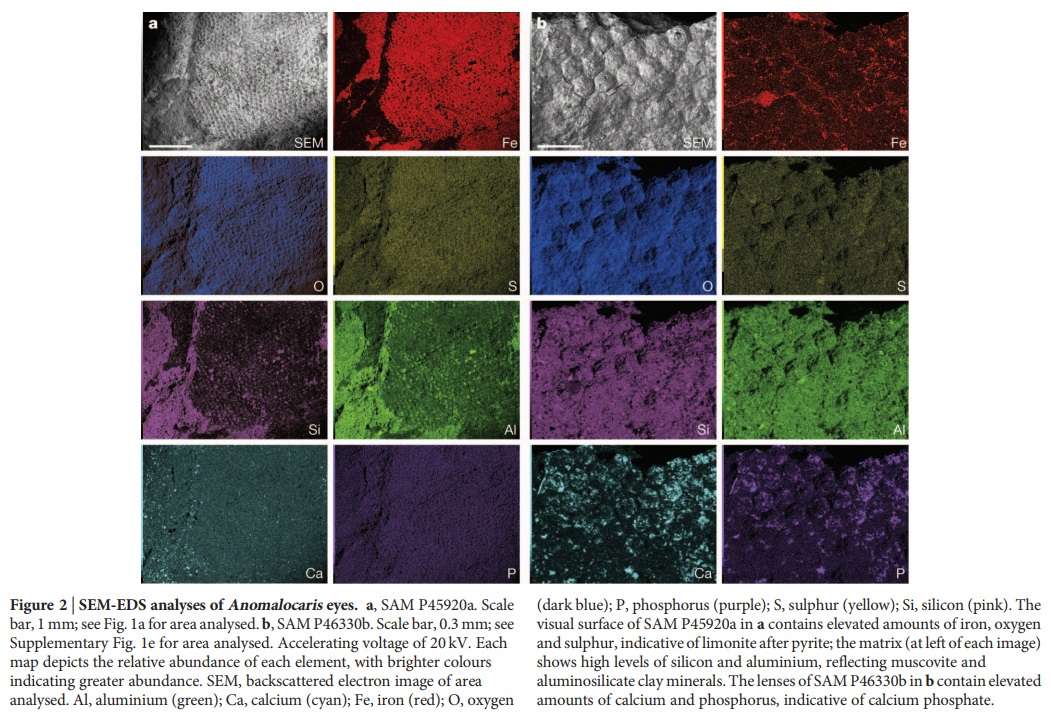
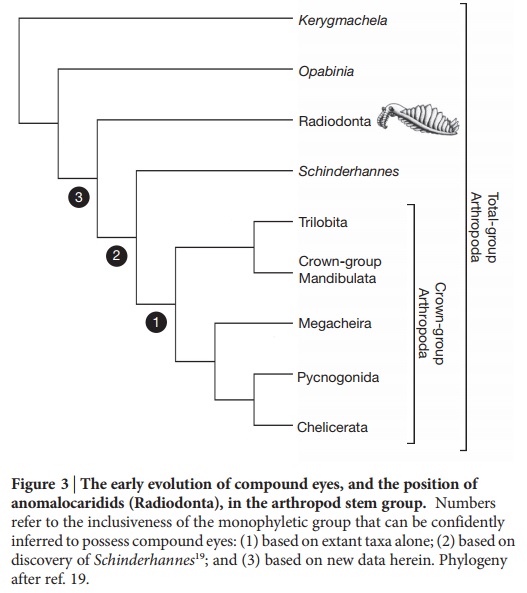
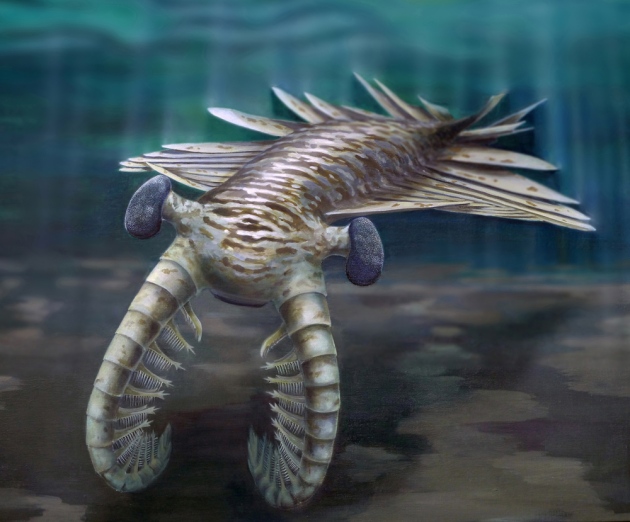
Armed with barbed grasping claws and a mouth full of tooth-like serrations, anomalocaridids are thought to have been the top predators in the Cambrian oceans about 500 million years ago. A cache of spectacular fossils now suggests that the ancient hunter Anomalocaris had compound eyes that gave it keener vision than many of the modern arthropods related to it. 5
6
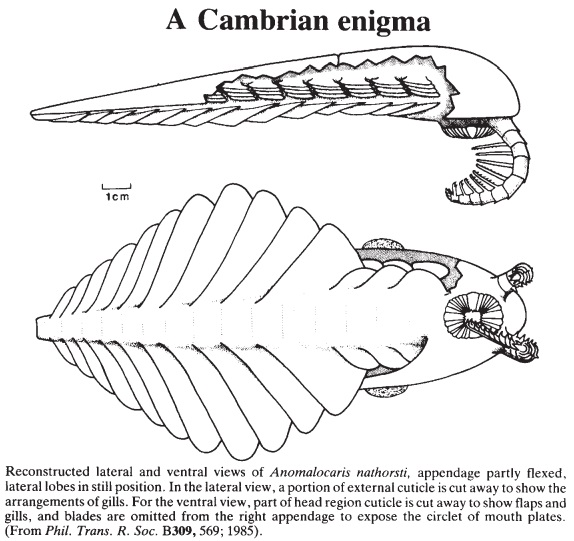
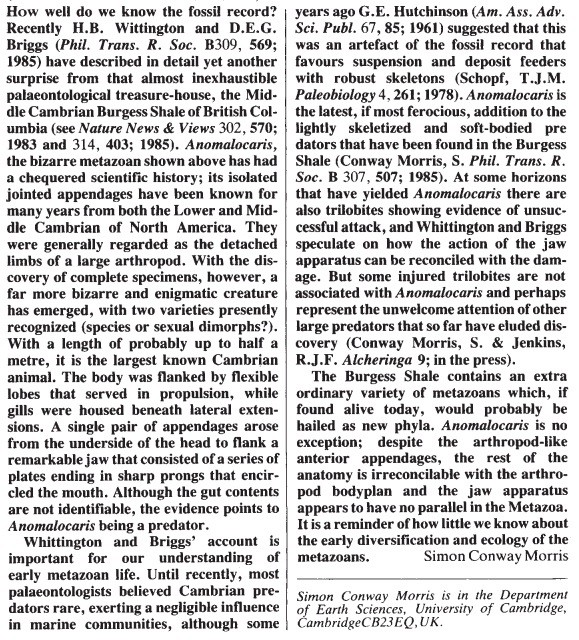
7


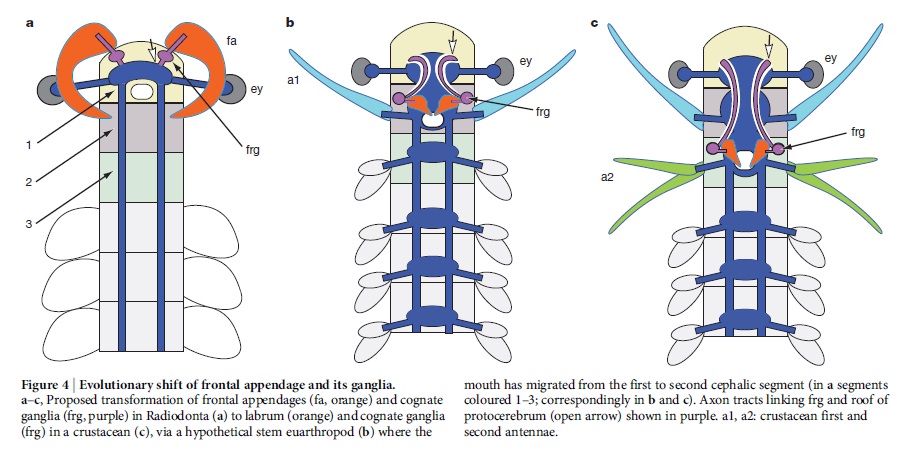
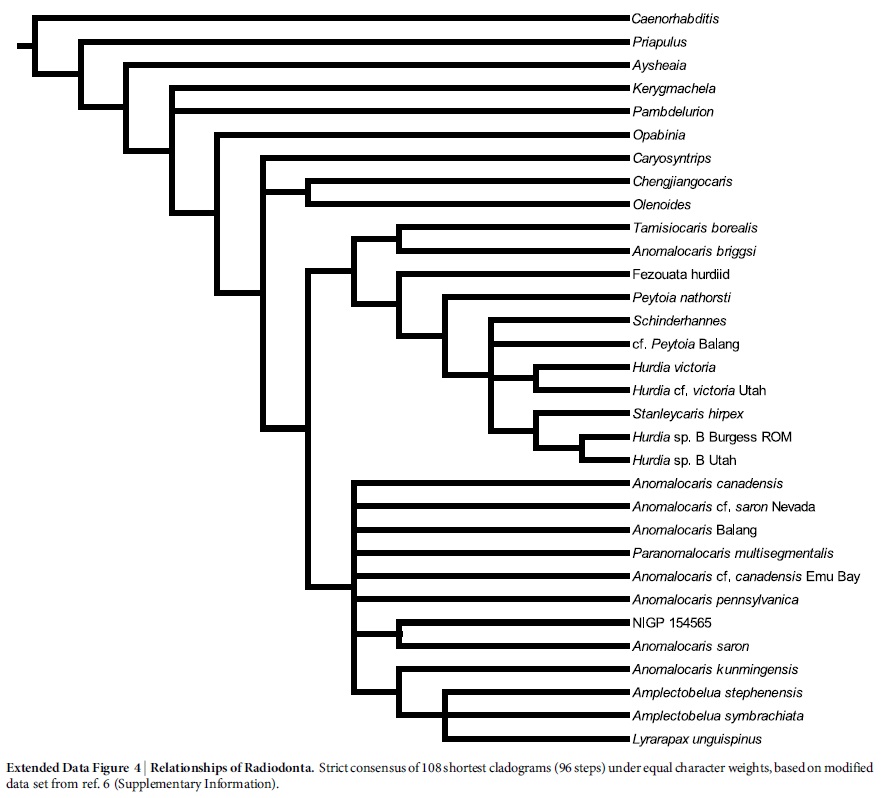
8

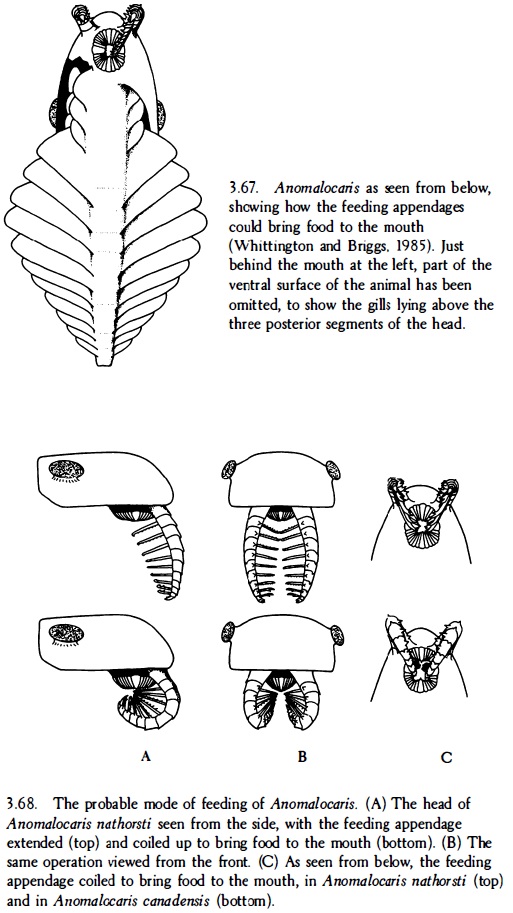

CAMBRIAN SHUTTER OF DOOM BECOMES SUCKER OF WORMS 9
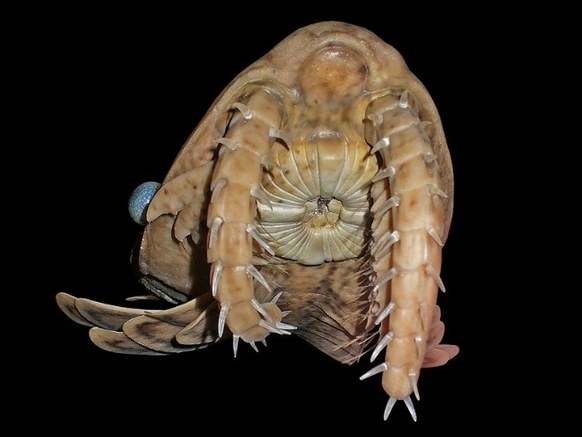
I HAVE A soft spot for Anomalocaris. Of all the Cambrian oddballs, this segmented invertebrate was one of the strangest. The prehistoric creature’s stalked eyes, swim flaps, spiked grasping appendages, and plated mouth gave this predator an exceptionally alien appearance. Anomalocaris was so weird, in fact, that paleontologists only recently assembled a complete picture of what this animal looked like. For years, the various parts of Anomalocaris were believed to be parts of various other creatures. What was eventually recognized as the neo-predator’s mouth was especially perplexing.
The mouth of Anomalocaris started off as a jellyfish. That’s a historical quirk, not a biological one. A century ago, as he was cataloging 505-million-year-old fossils from the exceptional Burgess Shale site, paleontologist Charles Doolittle Walcott puzzled over what seemed to be a flattened ring. Walcott called the animal Peytoia, and suggested that it was a strange form of archaic jellyfish.
Walcott’s interpretation stayed in place for decades. When paleontologists Harry Whittington and Simon Conway Morris wrote an article about Cambrian life for Scientific American in 1979, they included the odd jelly in a reconstructed Burgess Shale habitat. As Stephen Jay Gould later commented in his book Wonderful Life, the artistically-reinvigorated Peytoia looked like “a kind of Frisbee cum flying saucer cum pineapple slice.”
By 1985, however, those squishy discs were redeployed as the trilobite-crushing mouthparts of Anomalocaris and kin. As Whittington, Conway Morris, and additional collaborator Derek Briggs cleaned and studied various Cambrian fossils, they found that Peytoia - as Walcott envisioned it - was not a discrete creature, after all. Rare slabs preserved the rings on specimens of Anomalocaris and a similar, closely-related creature that was previously thought to be a sponge. These more complete specimens placed the circular mouth in context with the creature's grasping appendages, eye stalks, swim fins, and other weird parts. Where strange prehistoric Frisbees once flew, there were now at least two bizarre Cambrian apex predators unlike anything paleontologists had seen before.
The mouth of Anomalocaris looked like a camera-shutter of doom. I loved that imagery. Surely Anomalocaris nabbed unsuspecting trilobites with its flexible arms and fed the little arthropods directly into the crushing plates which constituted its mouth. And rare fossil feces – filled with trilobite bits – throw support to the idea that some anomalocaridids were munching on hard-shelled prey.
But the notion that anomalocaridids were specialized trilobite hunters is probably too simple, and has often been questioned. Two years ago, a GSA presentation about Anomalocaris stirred up a good deal of media attention when paleontologist James Whitey Hagadorn suggested that the Cambrian predator was physically incapable of eating hard-shelled prey. Maybe Anomalocaris fed on soft trilobites that had freshly molted, but, for the most part, the nightmarish predator was probably more of a threat to worms. (As far as I’m aware, Hagadorn’s study has not yet been published, and I haven’t seen any of the various presentations on the research delivered over the past few years.)
Indeed, as scary as the mouthparts of Anomalocaris look, I might have to shelve the idea that the creature rapaciously gobbled up trilobites. As explained by paleontologists Allison Daley and Jan Bergström in a new Naturwissenschaften paper, the mouth of Anomalocaris may have been better for sucking than pulverizing.
The mouths of Peytoia (A), Hurdia (B), and Anomalocaris canadensis (C). Notice that the mouth of Anomalocaris has a triradial, rather than tetraradial, organization. From Daly and Bergström, 2012.
As far as we know, there were three different anomalocaridids in the Burgess Shale fauna – Anomalocaris, *Peytoia *(commonly called Laggania*), and an even-weirder form with a pointy carapace called Hurdia. All three were believed to have very similar mouths. The standard arrangement, paleontologists thought, involved an “oral cone” made up of 32 plates, with four of those plates situated ninety degrees apart from each other. The other, spiny plates were distributed between the primary four.
*(The details are in the paper, but Daley and Bergström point out that the proper name for the animal Laggania is actually Peytoia. Even though the animal isn’t the jellyfish Walcott imagined, the name he coined in 1911 is the proper one.)
But when Daley and Bergström reexamined the mouths of Anomalocaris canadensis from the Burgess Shale, they found a different arrangement. This famous animal had only three large plates – arranged in a triangle – with a variable number of smaller plates between them. “This highlights a serious misunderstanding of one of the most renowned anomalocaridids,” Daley and Bergström wrote, and this new look at the creature’s oral cone shows that Anomalocaris probably wasn’t a trilobite-crushing terror. “The central opening of Anomalocaris oral cones has an irregular shape and small size,” Daley and Bergström explained, “making it unsuitable for strong biting motions.” The stiff, small, circular mouth of Anomalocaris looks better suited to sucking in small prey – perhaps the animal sifted through the Cambrian mud in search of worms and other tidbits.
Not all anomalocaridids had identical mouthparts, though. *Peytoia *and Hurdia had the classic four-part mouth shape, and Hurdia, in particular, possessed an extra array of small spines in the middle of its mouth. Clearly these animals were feeding on disparate prey and doing so in different ways – a conclusion supported by the variations in the spiny frontage appendages anomalocaridids used to grasp prey. “As opposed to being highly specialized trilobite predators, anomalocaridids were generalists occupying a range of ecological habits, from freeswimming ambush predators to sediment-sifting scavengers,” Daley and Bergström concluded. We’re only just starting to understand the ecology and biology of these absolutely fantastic animals. In this case, strange mouths hint that the celebrated idea of an intense Cambrian arms race between shutter-mouthed predators and trilobites was not as intense or dramatic as we thought.
The oral cone of Anomalocaris is not a classic ‘‘peytoia’’ 10
Abstract
The Cambro-Ordovician anomalocaridids are large ecdysozoans commonly regarded as ancestors of the arthropods and apex predators. Predation is indicated partly by the presence of an unusual “peytoia”-type oral cone, which is a tetraradial outer ring of 32 plates, four of which are enlarged and in perpendicular arrangement. This oral cone morphology was considered a highly consistent and defining characteristic of well-known Burgess Shale taxa. It is here shown that Anomalocaris has a different oral cone, with only three large plates and a variable number of smaller and medium plates. Its functional morphology suggests that suction, rather than biting, was used for food ingestion, and that anomalocaridids in general employed a range of different scavenging and predatory feeding strategies. Removing anomalocaridids from the position of highly specialized trilobite predators forces a reconsideration of the ecological structure of the earliest marine animal communities in the Cambrian.

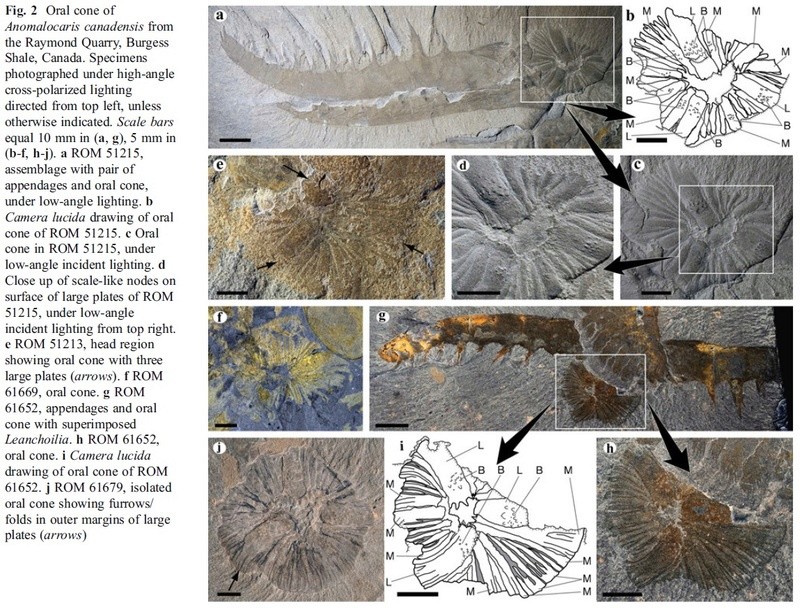
Giant anomalocaridids force dramatic revisions of the evolutionary timeline 11
Another recent example was the discovery of “extraordinarily well-preserved” fossils in Morocco. These were giant (length 1 meter, or 3 ft) shrimp-like creatures with soft bodies preserved along with “thousands of [other] examples of soft-bodied marine fauna” there.4 How so? They “were trapped by sediment clouds that buried them and preserved their soft bodies”. Note that the researchers were forced to substantially revise their timeline. They were ‘trapped’ by the evolutionary mindset that sedimentary rock layers with embedded fossils represent the order of evolution and extinction over millions of years rather than the order of burial during the Noachian Flood. They now say that “these animals existed for 30 million years longer than previously realized”. And the researchers also mentioned an earlier dramatic modification of the evolutionary story about these creatures. The discovery of complete specimens in the Burgess Shale showed that fossils that had been thought to be a multiplicity of different creatures actually “all belong to a single kind of animal”.
Fossil of giant ancient sea predator discovered 12
Paleontologists have discovered that a group of remarkable ancient sea creatures existed for much longer and grew to much larger sizes than previously thought, thanks to extraordinarily well-preserved fossils discovered in Morocco. The giant fossilized anomalocaridid measures one meter in length and dates back to the Ordovician period, suggesting these animals existed for 30 million years longer than previously realized. The creatures, known as anomalocaridids, were already thought to be the largest animals of the Cambrian period, known for the "Cambrian Explosion" that saw the sudden appearance of all the major animal groups and the establishment of complex ecosystems about 540 to 500 million years ago. Fossils from this period suggested these marine predators grew to be about two feet long. Until now, scientists also thought these strange invertebrates -- which had long spiny head limbs presumably used to snag worms and other prey, and a circlet of plates around the mouth -- died out at the end of the Cambrian.
A giant Ordovician anomalocaridid 13
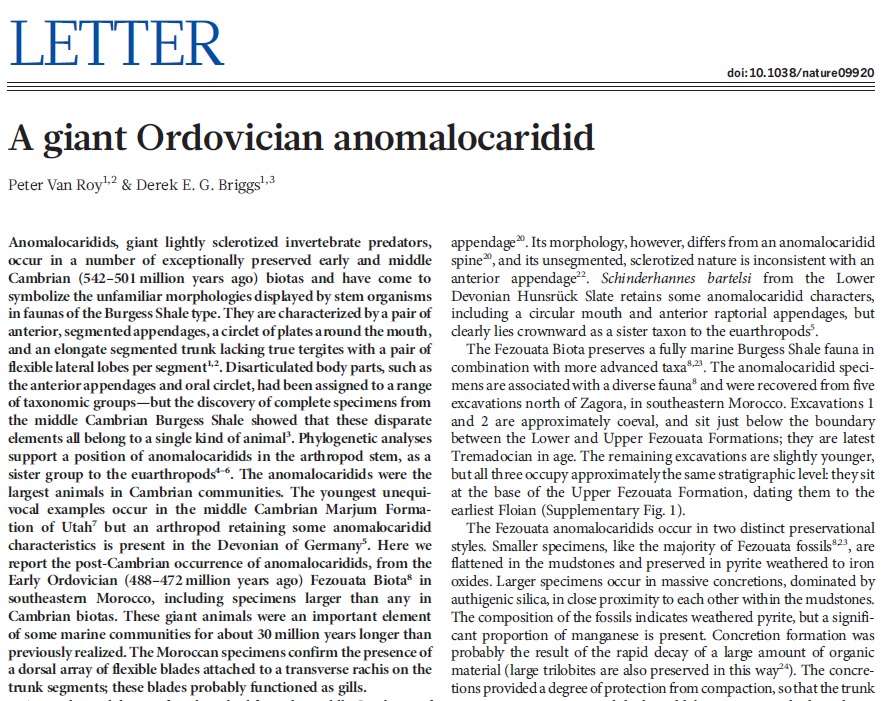
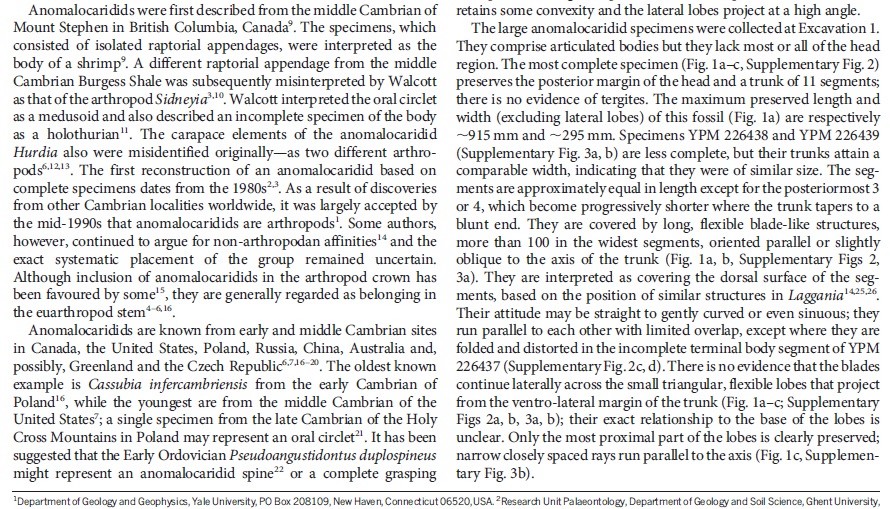

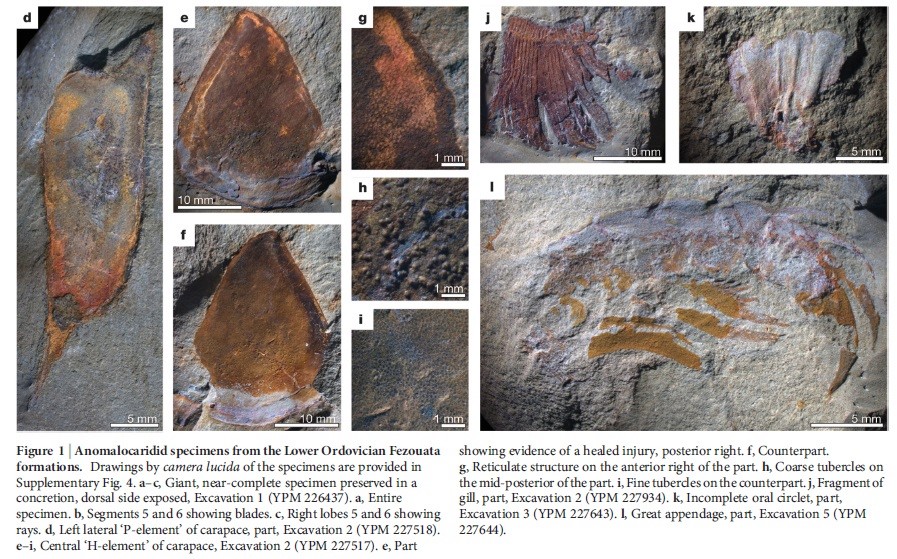
14

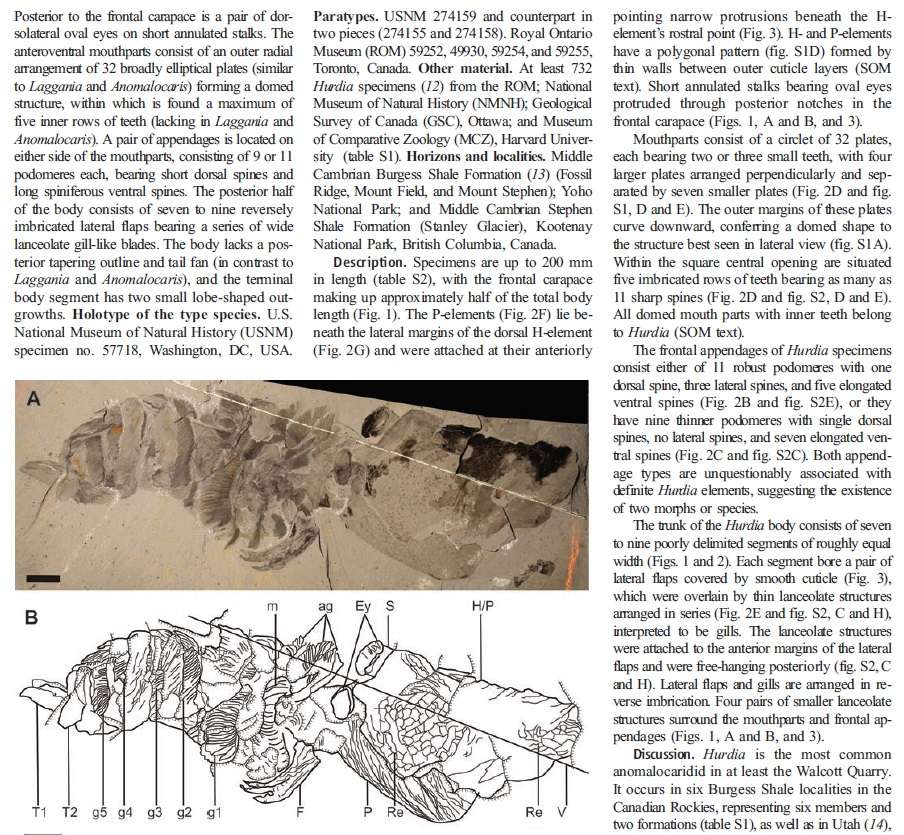
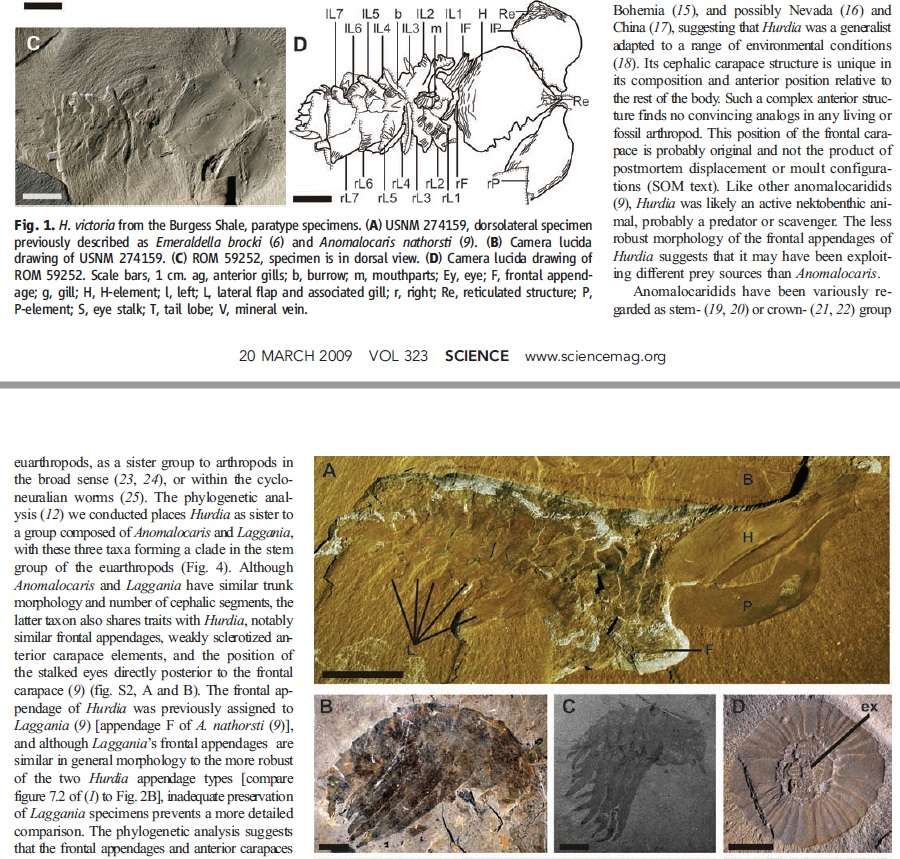
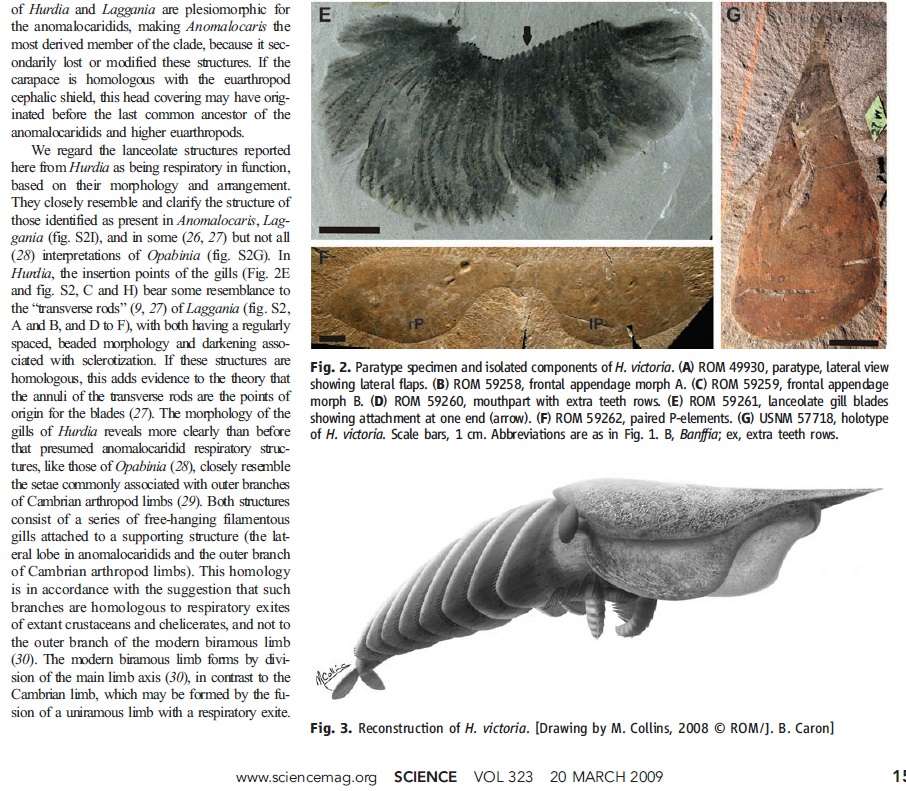
16
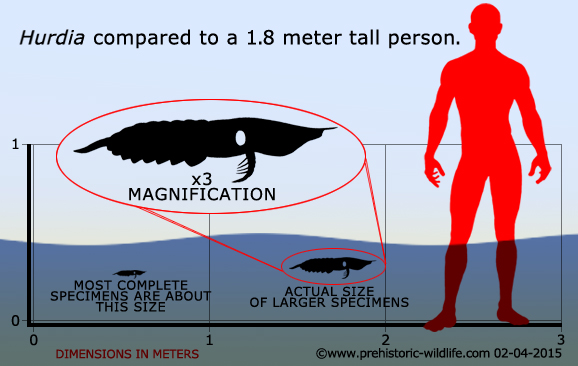
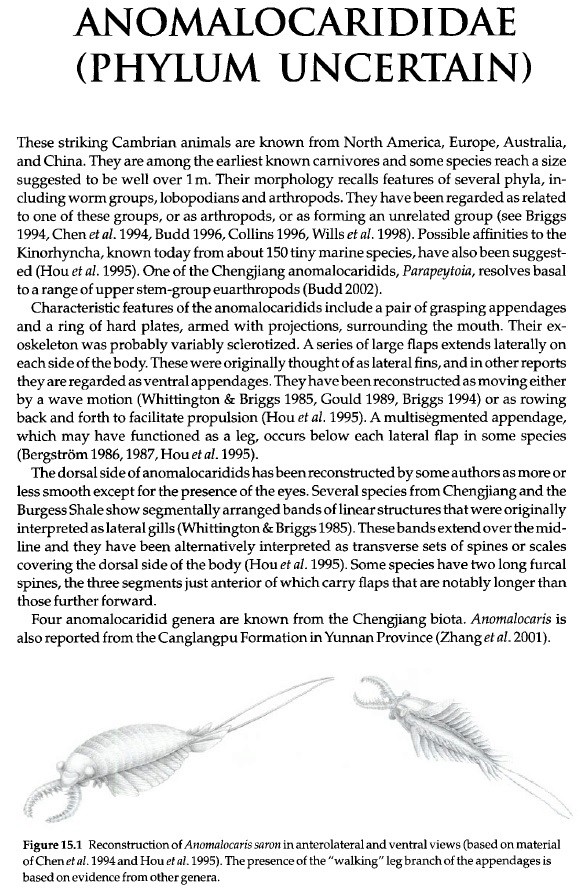
1. http://www.trilobites.info/background2.html
2. http://www.trilobites.info/background3.html
3. https://evolutionnews.org/2011/12/an_eye_opening/
4. https://sci-hub.bz/http://www.nature.com/nature/journal/v480/n7376/full/nature10689.html
5. http://www.nature.com/news/an-eye-opening-fossil-1.9586
6. https://sci-hub.bz/https://www.nature.com/nature/journal/v316/n6030/pdf/316677a0.pdf
7. https://sci-hub.bz/http://www.nature.com/nature/journal/v513/n7519/full/nature13486.html
8. Wonderful Life, The Burgess Shale and the Nature of History, STEPHEN JAY GOULD
9. https://www.wired.com/2012/05/cambrian-shutter-of-doom-becomes-sucker-of-worms/?+wired%252Findex+%2528Wired%253A+Index+3+%2528Top+Stories+2%2529%2529
10. https://sci-hub.bz/https://link.springer.com/article/10.1007/s00114-012-0910-8
11. https://creation.com/twice-as-wrong-and-more
12. https://www.sciencedaily.com/releases/2011/05/110525131709.htm
13. https://sci-hub.bz/https://www.nature.com/nature/journal/v473/n7348/full/nature09920.html
14. https://sci-hub.bz/http://science.sciencemag.org/content/323/5921/1597?maxtoshow=&HITS=10&hits=10&RESULTFORMAT=&fulltext=The%20Burgess%20Shale%20Anomalocaridid%20Hurdia%20and%20Its%20Significance%20for%20Early%20Euarthropod%20Evolution&searchid=1&FIRSTINDEX=0&resourcetype=HWCIT
15. THE CAMBRIAN FOSSILS OF CHENGJIANG, CHINA The Flowering of Early Animal Life
16. http://www.prehistoric-wildlife.com/species/h/hurdia.html
https://reasonandscience.catsboard.com/t2613-anomalocaris-another-science-fiction-like-creature
Stephen Meyer, Darwin's doubt, page 54:
There are many types of arthropods that arise suddenly in the Cambrian—trilobites, Marrella, Fuxianhuia protensa, Waptia, Anomalocaris —and all of these animals had hard exoskeletons or body parts. Moreover, the only known extant group of arthropods without a hard exoskeleton (the pentastomids) have a parasitic relationship with arthropods that do. Thus, surely, it seems likely that some of the near ancestors of the many arthropod animals that arose in the Cambrian would have left at least some rudimentary remains of exoskeletons in the Precambrian fossil record—if, in fact, such ancestral arthropods existed in the Precambrian and if arthropods arose in a gradual Darwinian way. Moreover, the arthropod exoskeleton is part of a tightly integrated anatomical system. Specific muscles, tissues, tendons, sensory organs—and a special mediating structure between the soft tissue of the animal and the exoskeleton called the endophragmal system—are all integrated to support the process of molting and exoskeletal growth and maintenance that is integral to the arthropod mode of existence.
A best-case Darwinian scenario for the origin of such a system would, therefore, envision the “co-evolution” of these separate anatomical subsystems in a coordinated fashion, since some of these anatomical subsystems confer a functional advantage to the animal largely by supporting, and promoting, the growth and maintenance of the exoskeleton (and vice versa). Others would be vulnerable to damage without it. Thus, it seems unlikely that these interdependent subsystems would evolve independently first without an exoskeleton, only to have the exoskeleton arise suddenly as a kind of accretion atop an already integrated system of soft parts at the end of a long evolutionary process.
This, again, makes it reasonable to expect that at least some rudimentary arthropod hard parts would have been preserved in the Precambrian if arthropods were present then. That such parts are unknown for all Cambrian arthropods (and brachiopods) in a fossil record that presumably favors hard-part preservation, seems at least curious. And it appears, on its face, to support the assertions of those Cambrian paleontologists such as Chen and Zhou who take the absence of any hard parts in the Precambrian record as evidence of the absence of those groups that typically depend on hard parts for their existence.
https://www.youtube.com/watch?v=ice47loNmsc
The Anomalocarid Bauplan 2
The studies of the mid to late 1990s have presented us with intriguing revelations, and the most complete fossils of anomalocaridids. The level of current research and discovery is at its most promising since Whittington and Briggs (1982, 1985) pieced together the first reasonable reconstruction of Anomalocaris.
The anomalocaridid bauplan (body plan)
All anomalocaridids are bilaterally symmetrical, bear a pair of anterior segmented appendages, these often sclerotized and armed with spines, a ventral anterior mouth is comprised of tooth-bearing sclerotized wedge-shaped segments arranged in a ring around a central aperture. Jaws, jaw segments, and anterior claws are more often preserved than the rest of the animal, suggesting that these parts are the most robust. Dorsolateral prominent eyes, most often a single pair placed to either side of the mouth, but sometimes either anterior or posterior of the mouth, are typically set on flexible stalks of various length. An elongate, metameric body bears numerous (typically 10+) pairs of lateral imbricating lobes, probably of natatorial function, sometimes accompanied by repeating sets of horizontal support rods. In the majority of species for which complete specimens are known, there are (typically three) pairs of prominent dorsolateral fins immediately posterior to the lateral lobes. 2

1

An Eye-Opening Discovery: The Remarkable Vision of Anomalocaris 3
December 8, 2011
The creature is in the news today thanks to new revelations about its fantastic vision. Sadly, it’s proven to be another tough day to be a Darwinian.
Like something out of science fiction, Anomalocaris (whose name means “strange shrimp”), with lengths ranging up to two meters, propelled itself with ease through the Cambrian waters by moving the lobes on the side of its body in a smooth, wavelike motion.
Bizarrely, the eyes of Anomalocaris were positioned on stalks on the side of the animal’s head. The popular science media are abuzz about a recent discovery — published in Nature and based on fossils found on Kangaroo Island, South Australia — that Anomalocaris possessed compound eyes similar to those that modern insects and arthropods have today. The only difference is that Anomalocaris had even more lenses per eye (according to the Paterson et al. Nature article, as many as 16,000 hexagonal lenses per eye) than most of those modern groups do. These remarkable eyes (which presumably would have required a reasonably advanced brain) would have afforded the creature very sharp vision. In fact, according to the Nature News report,
It is possible that the eyes of Anomalocaris had even more than 16,000 lenses — the fossils are detailed, but they are not perfect. In fossil form, the stalked eyes are flattened, like pancakes. But Paterson speculates that the eyes of a living anomalocaridid would have been bulbous, and that if non-flattened eyes were to be found, many more lenses would be discovered on the other side.
4





Armed with barbed grasping claws and a mouth full of tooth-like serrations, anomalocaridids are thought to have been the top predators in the Cambrian oceans about 500 million years ago. A cache of spectacular fossils now suggests that the ancient hunter Anomalocaris had compound eyes that gave it keener vision than many of the modern arthropods related to it. 5
6


7




8



CAMBRIAN SHUTTER OF DOOM BECOMES SUCKER OF WORMS 9

I HAVE A soft spot for Anomalocaris. Of all the Cambrian oddballs, this segmented invertebrate was one of the strangest. The prehistoric creature’s stalked eyes, swim flaps, spiked grasping appendages, and plated mouth gave this predator an exceptionally alien appearance. Anomalocaris was so weird, in fact, that paleontologists only recently assembled a complete picture of what this animal looked like. For years, the various parts of Anomalocaris were believed to be parts of various other creatures. What was eventually recognized as the neo-predator’s mouth was especially perplexing.
The mouth of Anomalocaris started off as a jellyfish. That’s a historical quirk, not a biological one. A century ago, as he was cataloging 505-million-year-old fossils from the exceptional Burgess Shale site, paleontologist Charles Doolittle Walcott puzzled over what seemed to be a flattened ring. Walcott called the animal Peytoia, and suggested that it was a strange form of archaic jellyfish.
Walcott’s interpretation stayed in place for decades. When paleontologists Harry Whittington and Simon Conway Morris wrote an article about Cambrian life for Scientific American in 1979, they included the odd jelly in a reconstructed Burgess Shale habitat. As Stephen Jay Gould later commented in his book Wonderful Life, the artistically-reinvigorated Peytoia looked like “a kind of Frisbee cum flying saucer cum pineapple slice.”
By 1985, however, those squishy discs were redeployed as the trilobite-crushing mouthparts of Anomalocaris and kin. As Whittington, Conway Morris, and additional collaborator Derek Briggs cleaned and studied various Cambrian fossils, they found that Peytoia - as Walcott envisioned it - was not a discrete creature, after all. Rare slabs preserved the rings on specimens of Anomalocaris and a similar, closely-related creature that was previously thought to be a sponge. These more complete specimens placed the circular mouth in context with the creature's grasping appendages, eye stalks, swim fins, and other weird parts. Where strange prehistoric Frisbees once flew, there were now at least two bizarre Cambrian apex predators unlike anything paleontologists had seen before.
The mouth of Anomalocaris looked like a camera-shutter of doom. I loved that imagery. Surely Anomalocaris nabbed unsuspecting trilobites with its flexible arms and fed the little arthropods directly into the crushing plates which constituted its mouth. And rare fossil feces – filled with trilobite bits – throw support to the idea that some anomalocaridids were munching on hard-shelled prey.
But the notion that anomalocaridids were specialized trilobite hunters is probably too simple, and has often been questioned. Two years ago, a GSA presentation about Anomalocaris stirred up a good deal of media attention when paleontologist James Whitey Hagadorn suggested that the Cambrian predator was physically incapable of eating hard-shelled prey. Maybe Anomalocaris fed on soft trilobites that had freshly molted, but, for the most part, the nightmarish predator was probably more of a threat to worms. (As far as I’m aware, Hagadorn’s study has not yet been published, and I haven’t seen any of the various presentations on the research delivered over the past few years.)
Indeed, as scary as the mouthparts of Anomalocaris look, I might have to shelve the idea that the creature rapaciously gobbled up trilobites. As explained by paleontologists Allison Daley and Jan Bergström in a new Naturwissenschaften paper, the mouth of Anomalocaris may have been better for sucking than pulverizing.
The mouths of Peytoia (A), Hurdia (B), and Anomalocaris canadensis (C). Notice that the mouth of Anomalocaris has a triradial, rather than tetraradial, organization. From Daly and Bergström, 2012.
As far as we know, there were three different anomalocaridids in the Burgess Shale fauna – Anomalocaris, *Peytoia *(commonly called Laggania*), and an even-weirder form with a pointy carapace called Hurdia. All three were believed to have very similar mouths. The standard arrangement, paleontologists thought, involved an “oral cone” made up of 32 plates, with four of those plates situated ninety degrees apart from each other. The other, spiny plates were distributed between the primary four.
*(The details are in the paper, but Daley and Bergström point out that the proper name for the animal Laggania is actually Peytoia. Even though the animal isn’t the jellyfish Walcott imagined, the name he coined in 1911 is the proper one.)
But when Daley and Bergström reexamined the mouths of Anomalocaris canadensis from the Burgess Shale, they found a different arrangement. This famous animal had only three large plates – arranged in a triangle – with a variable number of smaller plates between them. “This highlights a serious misunderstanding of one of the most renowned anomalocaridids,” Daley and Bergström wrote, and this new look at the creature’s oral cone shows that Anomalocaris probably wasn’t a trilobite-crushing terror. “The central opening of Anomalocaris oral cones has an irregular shape and small size,” Daley and Bergström explained, “making it unsuitable for strong biting motions.” The stiff, small, circular mouth of Anomalocaris looks better suited to sucking in small prey – perhaps the animal sifted through the Cambrian mud in search of worms and other tidbits.
Not all anomalocaridids had identical mouthparts, though. *Peytoia *and Hurdia had the classic four-part mouth shape, and Hurdia, in particular, possessed an extra array of small spines in the middle of its mouth. Clearly these animals were feeding on disparate prey and doing so in different ways – a conclusion supported by the variations in the spiny frontage appendages anomalocaridids used to grasp prey. “As opposed to being highly specialized trilobite predators, anomalocaridids were generalists occupying a range of ecological habits, from freeswimming ambush predators to sediment-sifting scavengers,” Daley and Bergström concluded. We’re only just starting to understand the ecology and biology of these absolutely fantastic animals. In this case, strange mouths hint that the celebrated idea of an intense Cambrian arms race between shutter-mouthed predators and trilobites was not as intense or dramatic as we thought.
The oral cone of Anomalocaris is not a classic ‘‘peytoia’’ 10
Abstract
The Cambro-Ordovician anomalocaridids are large ecdysozoans commonly regarded as ancestors of the arthropods and apex predators. Predation is indicated partly by the presence of an unusual “peytoia”-type oral cone, which is a tetraradial outer ring of 32 plates, four of which are enlarged and in perpendicular arrangement. This oral cone morphology was considered a highly consistent and defining characteristic of well-known Burgess Shale taxa. It is here shown that Anomalocaris has a different oral cone, with only three large plates and a variable number of smaller and medium plates. Its functional morphology suggests that suction, rather than biting, was used for food ingestion, and that anomalocaridids in general employed a range of different scavenging and predatory feeding strategies. Removing anomalocaridids from the position of highly specialized trilobite predators forces a reconsideration of the ecological structure of the earliest marine animal communities in the Cambrian.


Giant anomalocaridids force dramatic revisions of the evolutionary timeline 11
Another recent example was the discovery of “extraordinarily well-preserved” fossils in Morocco. These were giant (length 1 meter, or 3 ft) shrimp-like creatures with soft bodies preserved along with “thousands of [other] examples of soft-bodied marine fauna” there.4 How so? They “were trapped by sediment clouds that buried them and preserved their soft bodies”. Note that the researchers were forced to substantially revise their timeline. They were ‘trapped’ by the evolutionary mindset that sedimentary rock layers with embedded fossils represent the order of evolution and extinction over millions of years rather than the order of burial during the Noachian Flood. They now say that “these animals existed for 30 million years longer than previously realized”. And the researchers also mentioned an earlier dramatic modification of the evolutionary story about these creatures. The discovery of complete specimens in the Burgess Shale showed that fossils that had been thought to be a multiplicity of different creatures actually “all belong to a single kind of animal”.
Fossil of giant ancient sea predator discovered 12
Paleontologists have discovered that a group of remarkable ancient sea creatures existed for much longer and grew to much larger sizes than previously thought, thanks to extraordinarily well-preserved fossils discovered in Morocco. The giant fossilized anomalocaridid measures one meter in length and dates back to the Ordovician period, suggesting these animals existed for 30 million years longer than previously realized. The creatures, known as anomalocaridids, were already thought to be the largest animals of the Cambrian period, known for the "Cambrian Explosion" that saw the sudden appearance of all the major animal groups and the establishment of complex ecosystems about 540 to 500 million years ago. Fossils from this period suggested these marine predators grew to be about two feet long. Until now, scientists also thought these strange invertebrates -- which had long spiny head limbs presumably used to snag worms and other prey, and a circlet of plates around the mouth -- died out at the end of the Cambrian.
A giant Ordovician anomalocaridid 13




14




16


1. http://www.trilobites.info/background2.html
2. http://www.trilobites.info/background3.html
3. https://evolutionnews.org/2011/12/an_eye_opening/
4. https://sci-hub.bz/http://www.nature.com/nature/journal/v480/n7376/full/nature10689.html
5. http://www.nature.com/news/an-eye-opening-fossil-1.9586
6. https://sci-hub.bz/https://www.nature.com/nature/journal/v316/n6030/pdf/316677a0.pdf
7. https://sci-hub.bz/http://www.nature.com/nature/journal/v513/n7519/full/nature13486.html
8. Wonderful Life, The Burgess Shale and the Nature of History, STEPHEN JAY GOULD
9. https://www.wired.com/2012/05/cambrian-shutter-of-doom-becomes-sucker-of-worms/?+wired%252Findex+%2528Wired%253A+Index+3+%2528Top+Stories+2%2529%2529
10. https://sci-hub.bz/https://link.springer.com/article/10.1007/s00114-012-0910-8
11. https://creation.com/twice-as-wrong-and-more
12. https://www.sciencedaily.com/releases/2011/05/110525131709.htm
13. https://sci-hub.bz/https://www.nature.com/nature/journal/v473/n7348/full/nature09920.html
14. https://sci-hub.bz/http://science.sciencemag.org/content/323/5921/1597?maxtoshow=&HITS=10&hits=10&RESULTFORMAT=&fulltext=The%20Burgess%20Shale%20Anomalocaridid%20Hurdia%20and%20Its%20Significance%20for%20Early%20Euarthropod%20Evolution&searchid=1&FIRSTINDEX=0&resourcetype=HWCIT
15. THE CAMBRIAN FOSSILS OF CHENGJIANG, CHINA The Flowering of Early Animal Life
16. http://www.prehistoric-wildlife.com/species/h/hurdia.html

